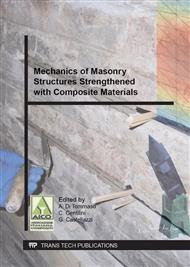[1]
S. Mahmoud, R. Jankowski, Elastic and inelastic multi-storey buildings under earthquake excitation with the effect of pounding, Journal of Applied Sciences 9 (2009) 3250-3262.
DOI: 10.3923/jas.2009.3250.3262
Google Scholar
[2]
R. Jankowski, Assessment of damage due to earthquake-induced pounding between the main building and the stairway tower, Key Engineering Materials 347 (2007) 339-344.
DOI: 10.4028/www.scientific.net/kem.347.339
Google Scholar
[3]
R. Jankowski, Non-linear FEM analysis of pounding-involved response of buildings under non-uniform earthquake excitation, Engineering Structures 37 (2012) 99-105.
DOI: 10.1016/j.engstruct.2011.12.035
Google Scholar
[4]
M.A. Aiello, F. Micelli, L. Valente, FRP Confinement of square masonry columns, ASCE J. Composites for Construction 13 (2009) 148-158.
DOI: 10.1061/(asce)1090-0268(2009)13:2(148)
Google Scholar
[5]
M. Corradi, A. Grazini, A. Borri, Confinement of brick masonry columns with CFRP materials, Composites Science and Technology 67 (2007) 1772-1783.
DOI: 10.1016/j.compscitech.2006.11.002
Google Scholar
[6]
A. Kwiecień, B. Zając, R. Jankowski, Static and dynamic properties of a flexible joint working in cracked historical masonries. 6th International Conference on Structural Analysis of Historic Construction, Bath, UK, 2008, Vol. 2, pp.931-939.
DOI: 10.1201/9781439828229.ch106
Google Scholar
[7]
T. Falborski, R. Jankowski, A. Kwiecień, Experimental study on polymer mass used to repair damaged structures. Key Engineering Materials 488-489 (2012) 347-350.
DOI: 10.4028/www.scientific.net/kem.488-489.347
Google Scholar
[8]
N. Lasowicz, R. Jankowski, Numerical analysis of a temporary steel grandstand, in: Shell Structures: Theory and Applications, CRC/Balkema, Leiden, Netherlands, 2014, pp.543-546.
DOI: 10.1201/b15684-136
Google Scholar
[9]
A. Kwiecień, B. Zając, Energy approach in analysis of masonry columns confined with GFRP mesh bonded on stiff and flexible adhesives, in: Structural Analysis of Historical Constructions, 2012, DWE, Wrocław, Poland, pp.1864-1872.
Google Scholar
[10]
A. Kwiecień, B. Zając, Dynamic response of the cracked masonry building repaired with the Flexible Joint Method – an innovative earthquake protection, Proc. 7th International Conference on Structural Dynamics EURODYN, Southampton, UK, 2008, paper E 2.
Google Scholar
[11]
R. Jankowski, Nonlinear rate dependent model of high damping rubber bearing, Bulletin of Earthquake Engineering 1 (2003) 397-403.
DOI: 10.1023/b:beee.0000021512.74990.45
Google Scholar
[12]
S. Mahmoud, P-E. Austrell, R. Jankowski, Simulation of the response of base-isolated buildings under earthquake excitations considering soil flexibility, Earthquake Engineering and Engineering Vibration 11 (2012) 359-374.
DOI: 10.1007/s11803-012-0127-z
Google Scholar


